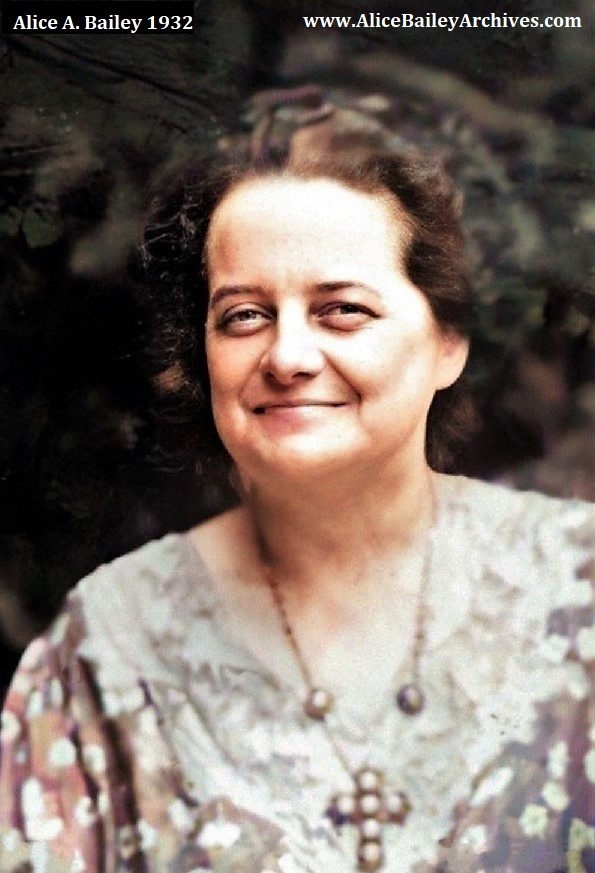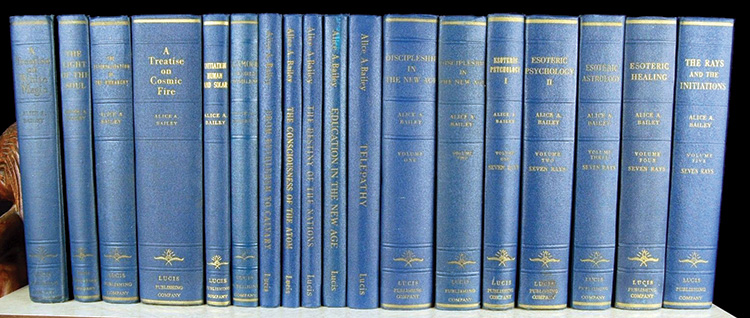 Submitted by Morgana on
Submitted by Morgana on

Derivative Images
One of the most controversial figures to emerge from the Theosophical Society (TS) in the early twentieth century grew up a devout Christian far removed from occult circles. For many decades her faith was unshakeable, yet the seeds of her conversion lay in her introspective nature and sensitivity to mysticism.
In the scholarly milieu, she is considered to be the mother of the New Age movement, harnessing the term circulating among occultists and the spiritually minded in her milieu, and composing a series of foundational texts which provide much of the theoretical basis of New Age thinking.
The obscure Theosophist has left a hidden legacy that continues to this day to influence world affairs behind the scenes through various key roles, bodies and organisations operating within the United Nations. The degree of influence is difficult to gauge, but conspiracy theorists would argue it is significant.

Alice Ann Bailey (1880–1949) was born into the aristocratic La Trobe-Bateman family. Among her ancestors are Victoria’s first governor, Charles La Trobe, and the renowned book illuminator, Edward La Trobe. Other notables include neoclassical architect Benjamin Henry Boneval La Trobe and Alice’s grandfather, civil engineer John Frederick La Trobe Bateman.
Unlike her younger sister, Alice deviated from the path her family expected her to tread. She did not marry, and she had no interest in pursuing a university education. Instead, adhering to her unwavering belief in the need for the salvation of souls, she worked as a missionary in soldier’s homes for the British army in Ireland and India, expounding the Gospels, entertaining the men playing checkers, serving cocoa and eggs, and sitting beside the ill and dying.
Her time in India came to an abrupt end when she suffered a physical and psychological breakdown. Her faith, which she had held dear for so long, began to waver. It was then she fell in love with a soldier in the Hussar regiment, Walter Evans. It was an unfortunate match. The couple moved to Cincinnati where Walter attended Lane Theological Seminary.
Three daughters and numerous bruises later, Alice managed to free herself from Walter’s violence. She then spent several years packing sardines in one of Monterey’s canneries, made famous by John Steinbeck in Cannery Row.
It was during this period that Alice converted to Theosophy after attending a lecture at the home of some acquaintances. She devoured the teachings and received guidance from founder Madame Helena Blavatsky’s personal students. Before long, Alice was giving her own classes in Theosophy.
Consumed by this new body of knowledge, she moved to the Theosophical headquarters at Krotona, Hollywood, where she worked in the café. As soon as she could, she joined the elite Esoteric Section of the society.
In January 1919, Alice Evans met her second husband, Foster Bailey, a lawyer and Freemason from Massachusetts born into a distinguished family of politicians and lawyers, hailing on the maternal line from founding father of Fitchburg, Amos Kimball. The couple soon took on key administrative roles in the TS, Foster as secretary and Alice as editor of the sectional magazine.
Around October of that year, Alice began writing as amanuensis for The Tibetan or Djwhal Khul, one of the Theosophical Masters of Wisdom. The Tibetan had also been Blavatsky’s master, from which her seminal text The Secret Doctrine arose. Reluctant at first, Alice took on the role of writing for The Tibetan, a role that would culminate in twenty-four volumes of esoteric teachings and commentary, a number written in her own right and many published posthumously. The collection became known as the Blue Books due to their indigo covers.
A year later, an organisational row resulted in both Alice and Foster being ousted from their roles in the TS. They moved to New York where Foster was offered work as secretary of a Theosophical association. The couple quickly married and settled in Ridgefield Park, NJ. While Foster continued to campaign to change key organisational practices of the TS, Alice continued writing as she visioned their future.
She established a Secret Doctrine class held in a room on Madison Avenue, which became an outstanding success. Interest grew and grew from all over the United States and beyond, and correspondence mounted. In 1922, the Baileys established the Lucis Trust and published the first three volumes of her opus. In 1923, they founded the Arcane School – an esoteric training school delivered by correspondence to disciples around the world.
Alice Bailey would dedicate the rest of her life to laying the foundations of a new age of spiritual enlightenment, in the hope of countering the continued rise of materialism, hatred and greed.
The Blue Books
Alice Bailey’s body of work is in part a reformulation of the Theosophical current of Western Esotericism, composed in language accessible to the contemporary mind. Central to Theosophy are: a belief in the existence of the soul, reincarnation and the interconnectedness of all existence; an epochal view of evolution that includes consciousness; the transmission of an Ageless Wisdom from master to disciple; and a commitment to humanitarianism.

http://www.newdawnmagazine.com
There is nothing fluffy between the pages of the Blue Books. The atmosphere the teachings evokes is business-like, with an emphasis on responsibility, leadership and executive management. The volumes are instructional texts for aspirants and disciples of the spiritual path. Some are harder to read than others. The volumes include A Treatise on Cosmic Fire, an intricate cosmology drawing on Neoplatonist metaphysics and Eastern philosophy. Other works provide instructions for disciples on how to live, think and behave. A Treatise on the Seven Rays provides a detailed formulation of human psychology and advice on meditation and healing.
Cemented in Alice Bailey’s particular version of Theosophy are Christian ideas of goodwill and good works, and she sought to make these basic principles the cornerstones of her teachings. She made it her mission to elevate occultism from the lower reaches of charlatans and counter the left-hand path some occultists follow. For Alice Bailey, esoteric thought and practice needed to be oriented towards selfless, altruistic goals and always for the good of the whole.
Controversies
Despite these noble aims, during her lifetime Alice Bailey aroused the wrath of purist Theosophists, Christians and Jews who all took issue with her body of work.
Purist Theosophists accused Alice Bailey of false claim-making over her assertion that the source of most of her writings was none other than Blavatsky’s master Djwhal Khul. That she was merely a conduit in telepathic rapport receiving the next outpouring of the Ageless Wisdom provided her with a handy disclaimer should any issues of copyright or plagiarism arise. Some even alleged Alice Bailey made use of secret Theosophical teachings only available to members of the society’s Esoteric Section, a matter that cannot be proven as the teachings have not been made available in the public domain.
She upset members of the Jewish community through her criticisms of their exclusive practices and an attachment to the notion of a Chosen People, which separated Jews from the rest of humanity in her eyes. Controversy also surrounds interpretations of the Theosophical root races, which appear to position Jews as less advanced. She trod sensitive ground even then, although to her credit some of her closest allies and co-workers were Jewish, including renowned psychiatrist Roberto Assagioli, who was highly influential in the foundation of humanistic and transpersonal psychology. Today, the Lucis Trust has issued an explanation of Alice Bailey’s position on the Jewish faith which can be found on their website.
The Lucis publishing company started life as the Lucifer Publishing Company; an unfortunate choice and Alice Bailey quickly changed the name when she realised the upset it was causing among fundamentalist Christians. Her original choice stuck in the minds of later Christians, including author Constance Cumbey, who uses the original name to take Alice Bailey to task over her alliance with pure evil. Conspiracy thinkers cite the same.
Throughout her writing life, Alice Bailey strove to gain credibility in academic circles. She wanted her texts to be taken seriously and set apart from the gamut of occult literature being published at the time. She solicited forewords and prefaces from sympathetic scholars including popular psychologist Harry Allen Overstreet and eminent professor of philosophy Oliver L Reiser. Not having received a tertiary education, she was at pains to include references to leading scholars in the fields of psychology, philosophy and religion, including the eminent psychiatrist Carl Jung. She met with some success but failed to achieve acceptance among the intellectual milieu.
She rose above all of these threats to her reputation and credibility, yet a close reading of her unfinished autobiography reveals a defensive tone in relation to her husband, her daughters, her views on Jews, her own Christian fundamentalism and the Theosophical Society. It is transparent that she was painfully aware of her critics and sought to counter their claims.
Influencing the New Age Movement
Alice Bailey can be called the mother of the New Age movement if for no other reason than she set out to give birth through her texts, organisations and followers to a new and spiritually informed world order. Many who know of and respect Alice Bailey can be found in the New Age movement, yet few may realise just how influential her work has been in the movement’s foundation.
The New Age began as a utopian counter culture which rejected mainstream beliefs and values and searched for alternatives. The roots of the New Age are deep and can be traced back at least to the 1800s when interest in spirituality as an alternative to mainstream religion and dull intellectualism burgeoned, culminating, in esoteric circles, in the founding of the Theosophical Society in 1885. Alice Bailey, along with Rudolf Steiner and Krishnamurti, brought Theosophical teachings to their own audiences, helping to perpetuate continuing interest in the Ageless Wisdom.
Hopes for a new utopian age were prevalent in Europe, Britain and America in the 1920s and 30s, at a time when the occult and spirituality to some degree fused. While dedicated seekers were committing to particular currents, dabblers and ‘armchair enthusiasts’ tried out or considered various strands, everything from the ideas of Mary Swainson, through Gurdjieff, Ouspensky, Meher Baba, Sufism, Rosicrucianism, Wicca and Jung, along with the aforementioned Theosophists.
Alice Bailey was a prominent figure in the scene. She lectured far and wide. The Beacon was acknowledged to be a high-quality occult periodical.Book reviews and her letters appeared in the prestigious Occult Review.
What others may have lacked and Bailey had in abundance was a highly focused missionary zeal. Everything she did in every hour of every day for thirty years was devoted to her cause. Her single-mindedness fuelled a similar dedication in her students, especially among her Arcane School graduates, those who have carried forward her vision. She continues to draw towards her, out of the general pool of seekers, those who are as serious, focused and committed as she.
The Lucis publishing company started life as the Lucifer Publishing Company; an unfortunate choice and Alice Bailey quickly changed the name when she realised the upset it was causing among fundamentalist Christians. Her original choice stuck in the minds of later Christians, including author Constance Cumbey, who uses the original name to take Alice Bailey to task over her alliance with pure evil. Conspiracy thinkers cite the same.
Throughout her writing life, Alice Bailey strove to gain credibility in academic circles. She wanted her texts to be taken seriously and set apart from the gamut of occult literature being published at the time. She solicited forewords and prefaces from sympathetic scholars including popular psychologist Harry Allen Overstreet and eminent professor of philosophy Oliver L Reiser. Not having received a tertiary education, she was at pains to include references to leading scholars in the fields of psychology, philosophy and religion, including the eminent psychiatrist Carl Jung. She met with some success but failed to achieve acceptance among the intellectual milieu.
She rose above all of these threats to her reputation and credibility, yet a close reading of her unfinished autobiography reveals a defensive tone in relation to her husband, her daughters, her views on Jews, her own Christian fundamentalism and the Theosophical Society. It is transparent that she was painfully aware of her critics and sought to counter their claims.
Alice Bailey & the United Nations
The New Age Alice Bailey sought to inspire took a new turn during World War II. In response to the evils of dictatorship, Bailey, like many others of her time, yearned for better governance. She was distressed by the war, deeply affected by the suffering she saw and appalled by the aggressor nations. She argued the need for a new world order, one founded on ideas of equality, goodwill and leadership. She advocated equality of opportunity for all, individual freedom and autonomy, the eradication of poverty, the sovereign rights of all nations, a universal education, shared resources distributed fairly, and disarmament.
She had no outward anchor for her reflections until 1st January 1942, when government representatives of twenty-six nations pledged to fight against the Axis powers and signed the Declaration of the United Nations, a declaration that led to the founding of the United Nations on 24th October 1945 in San Francisco, when its charter was ratified. Until then, all her efforts were poured into training disciples who were to go off in their various directions in the capacity of world service. The United Nations gave Bailey a focus and from then on she directed her disciples towards the organisation.
Her support of the United Nations is unsurprising, the organisation representing a dovetailing of her spiritual ethos with the pressing concerns of the era to address the situation that had led to another world war, not least a widespread desire to create some form of international law designed to protect individuals and groups from abuses meted out by nation states, challenging the idea that a nation has an inviolable right to treat its citizens or anyone within its borders however it wishes. Through Alice Bailey’s eyes, there was at last hope of a better world, one founded on unity, goodwill and right relations.
Alice Bailey’s call for a New World Order and support of the United Nations have resulted in an uproar among conspiracy theorists. Conspiracists are not wrong when they point to the infiltration of the UN by Alice Bailey’s co-workers. Membership of the UN’s Spiritual Caucus is filled with her people. Her organisation, World Goodwill, is a UN NGO. In 1952, Eleanor Roosevelt read Alice Bailey’s prayer, The Great Invocation, on a radio broadcast from the UN building in New York.
One key UN figure closely associated with Alice Bailey is Robert Muller, who served in the UN for forty years and was assistant to three Secretary Generals. Muller devised the World Core Curriculum for which he was awarded the UNESCO Peace Education Prize in 1989, a curriculum loosely based on Alice Bailey’s Education in the New Age. He contributed to Alice Bailey’s magazine, The Beacon, and addressed Arcane School conferences.
A coterie of influential figures operating out of plain sight would arouse suspicion in most of us. When those individuals believe in and are practising a form of occultism, suspicions inflame. And when the focus of activity is the United Nations – a locus for the New World Order – the result is a perfect storm of fear, speculation and evidence gathering. Whether Alice Bailey deserves it or not, she has become a pet hate among conspiracists.
The Passing of a Remarkable Occultist
Alice Bailey passed away in December 1949 with her husband Foster at her bedside. She had been ill for many years. Among her health conditions, she suffered from pernicious anaemia. Symptoms are wide-ranging and incapacitating. Even with treatment, the condition can be debilitating and painful. Alice received regular blood transfusions. Despite this, she worked tirelessly to the very end, holding executive meetings from her hospital bed.
After her death, Foster and their closest co-workers set about continuing the work. The Lucis Trust continues to publish the Blue Books in twenty languages and maintains and promotes the organisations she founded. Her co-workers to this day occupy key roles within the United Nations, and her texts continue to influence alternative spirituality and Western esoteric understanding and practice.
Alice Bailey’s version of esoteric truth is meant to foster goodwill and right relations. It is up to the individual to decide if it does.
Isobel Blackthorn
https://www.newdawnmagazine.com/articles/alice-a-bailey-mother-of-the-new-age-or-the-new-world-order
© Copyright New Dawn Magazine, www.newdawnmagazine.com. Permission granted to freely distribute this article for non-commercial purposes if unedited and copied in full, including this notice.
© Copyright New Dawn Magazine, www.newdawnmagazine.com. Permission to re-send, post and place on web sites for non-commercial purposes, and if shown only in its entirety with no changes or additions. This notice must accompany all re-posting.
- 805 reads